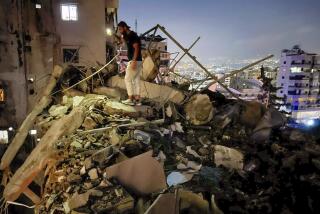‘81 Israeli Raid on Iraq Reactor Called Crucial
- Share via
JERUSALEM — Israeli leaders now are crediting a 1981 air strike against an Iraqi atomic reactor with preventing President Saddam Hussein from being able to threaten the United States and its Persian Gulf allies with nuclear weapons.
That daring raid against the Osirak reactor outside Baghdad was carried out with precision by U.S.-made F-15 and F-16 fighter-bombers--the same type of planes the United States is deploying in Saudi Arabia today.
Israeli military specialists and scientists are convinced that if the 1981 air strike had not been undertaken, Iraq today would have generated enough plutonium at Osirak to produce nuclear weapons.
Such a capability, they maintain, would have meant a totally different strategic balance facing the United States, moderate Arabs, and Western nations in the current gulf crisis.
At the time, the strike against the reactor was opposed beforehand by Labor Party leader Shimon Peres and condemned afterward by, among others, the U.S. ambassador to the United Nations, Jeane J. Kirkpatrick.
The outcry over the attack was climaxed by Saddam Hussein himself calling on “all peace-loving nations of the world” to assist Arabs in obtaining atomic weapons to counterbalance Israeli nuclear capabilities.
The spectacular raid, a textbook example of a raid of its kind, is still shrouded in secrecy. None of the 14 Israeli pilots involved has ever been identified because they have continued to fly hazardous missions and could, if shot down, fall into enemy hands.
Over the years, some details of the Osirak operation have leaked out.
The raid was a year in preparation, after the Israeli government concluded that the French-built nuclear reactor outside of Baghdad would be capable of producing weapons-grade atomic fuel.
The strike force consisted of eight newly arrived U.S.-made F-16 Falcons carrying two 2,000-pound bombs apiece and protected by six F-15 Eagles as escorts.
The plan called for a single formation to take off from an air base in the Sinai Desert on the afternoon of June 7, a Sunday when Israeli planners believed that the 100 to 150 foreigners working at the atomic complex would have the day off.
The formation flew eastward at a high altitude along the Jordan-Saudi Arabian border, avoiding heavy air defenses in northern Jordan, which would have been a shorter route.
Arabic-speakers among pilots could converse if necessary to give the impression the flight was a Jordanian training mission.
Approaching a point on the Saudi-Iraq border southwest of Baghdad, the flight doglegged, descended sharply, and bore in toward the Iraqi capital, skimming the desert floor.
The bombers--with a setting sun behind them and in the defenders’ eyes--hit the Osirak complex with complete surprise and pinpoint accuracy at 6:30 p.m.
They made their getaway through anti-aircraft fire and returned to Israel safely. In all, they had flown considerably more than 1,000 miles through Arab territory.
More to Read
Sign up for Essential California
The most important California stories and recommendations in your inbox every morning.
You may occasionally receive promotional content from the Los Angeles Times.













